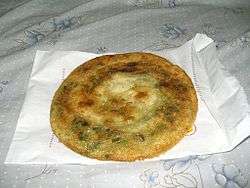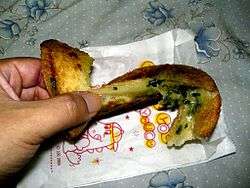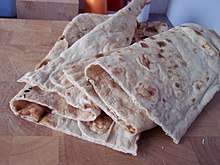Cong you bing
Cong you bing (simplified Chinese: 葱油饼; traditional Chinese: 蔥油餅; pinyin: cōngyóubǐng; lit.: 'scallion oil pancake'; Mandarin pronunciation [tsʰʊ́ŋjǒupìŋ]), also known as scallion pancake, is a Chinese, savory, unleavened flatbread folded with oil and minced scallions (green onions). Unlike Western pancakes, it is made from dough instead of batter. It is pan-fried which gives it crisp edges yet also a chewy texture. A unique characteristic of scallion pancakes is the many layers that make up the interior, which help contribute to its chewy texture.[1] Variations exist on the basic method of preparation that incorporate other flavors and fillings.
Spring onion pancakes in Taichung (2013) | |
| Alternative names | scallion pancake |
|---|---|
| Type | Flatbread |
| Place of origin | China |
| Main ingredients | Dough, scallions |
| Cong you bing | |||||||||||||||||
|---|---|---|---|---|---|---|---|---|---|---|---|---|---|---|---|---|---|
| Traditional Chinese | 蔥 油 餅 | ||||||||||||||||
| Simplified Chinese | 葱 油 饼 | ||||||||||||||||
| Literal meaning | scallion oil pancake | ||||||||||||||||
| |||||||||||||||||
Scallion pancakes are served both as a street food item and as a restaurant dish. They are also sold commercially, either fresh or frozen in plastic packages (often in Asian supermarkets).


Variations and accompaniments
Other ingredients, such as chopped fennel greens and sesame seeds are sometimes added with the green onions.
When using garlic chives (jiucai), these pancakes are called jiucai bing (韭菜饼) or jiucai you bing (韭菜油饼).
In Taiwanese cuisine, egg pancakes (蛋餅) are sauteed with egg coated on one side and the dough is thinner and moister.
In North America, the pancakes are often served with soy sauce, hot chili sauce, or Vietnamese dipping sauce.
Chinese legend surrounding the invention of pizza
There is a story in China that suggests pizza is an adaptation of the scallion pancake, brought back to Italy by Marco Polo. A humorous newspaper article, that also includes Marco Polo inventing cheese fondue when he is lost in the Alps and wants to eat Chinese hotpot, describes the invention of pizza this way:[2]
Marco Polo missed scallion pancakes so much that when he was back in Italy, he tried to find chefs willing to make the pancake for him. One day, he managed to meet a chef from Naples at a friend's dinner party and persuaded him to try recreating the dish. After half a day without success, Marco Polo suggested the filling be put on top rather than inside the dough. The change, by chance, created a dish praised by everyone at the party. The chefs returned to Naples and improvised by adding cheese and other ingredients and formed today's pizza.
Historical evidence in Europe suggests that pizza was not transmitted to Europe by Marco Polo, but existed in the Mediterranean long before his time.[3][4] The first recorded use of the word "pizza" dates from 997 AD (in a Latin text from the town of Gaeta in Southern Italy),[5] more than 250 years before Marco Polo was born.
Similar dishes
Similar dishes in Chinese culture, and in other cultures, exist:
- East Asia
- Laobing (Chinese culture)
- Negiyaki (ねぎ焼き) variant of okonomiyaki (Japanese)
- Pajeon (Korean)
- Elsewhere
References
| Wikimedia Commons has media related to Cong you bing. |
- "Authentic Chinese Scallion Pancake (CongYouBing)." The Mini Chef. Retrieved 2020-05-26.
- Xinhua, 12 September 2007, "Pizza and Ice Cream: The Chinese Delicacies Marco Polo Brought Back to the West." Archived 11 June 2011 at the Wayback Machine (Chinese).
- "The History Of Pizza." The Nibble. Retrieved 2013-05-31.
- Olver, Lynne. "Marco Polo & the Merchants of Venice". The Food Timeline. Retrieved 31 May 2013.
- Ceccarini, Rossella (2011). Pizza and Pizza Chefs in Japan: A Case of Culinary Globalization. Leiden: Brill. p. 19. ISBN 978-90-04-19466-3.


